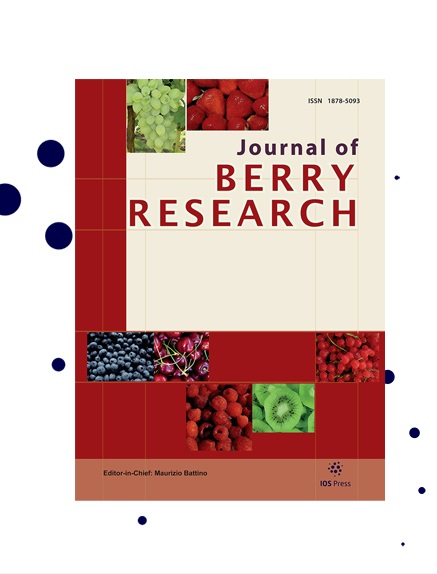Comparative transcriptome analysis reveals genes and pathways associated with anthocyanins in strawberry
IF 1.4
4区 农林科学
Q3 PLANT SCIENCES
引用次数: 5
Abstract
BACKGROUND: Anthocyanins are not only one of the most important antioxidants in plants but also responsible for the coloration in strawberry (Fragaria×ananassa), it is suggested to be associated with ascorbic acid (AsA), sugars and plant hormones metabolism. OBJECTIVE: To elucidate the molecular differences of genes and pathways in the presence and absence of anthocyanins. METHODS: RNA sequencing (RNAseq) of red-fleshed strawberry ‘Benihoppe’ and its white-fleshed mutant ‘Xiaobai’ was performed. RESULTS: A total of 1,156 and 1,378 transcripts were differentially expressed (DE) in two cultivars at white stage and red stage respectively. Among them, 28, 49 and 72 DE transcripts were involved in AsA, sugars metabolism and plant hormones signaling respectively. Fruits of ‘Benihoppe’ with higher anthocyanins content contained higher AsA, the expression of D-galacturonate reductase (GalUR) in white-fleshed strawberry was down-regulated. Particularly, the expression of transcripts involved in sugars, jasmonic acid (JA) and abscisic acid (ABA) signaling was decreased, by contrast, the expression of transcripts involved in auxin and gibberellins (GAs) signaling was significantly increased. CONCLUSIONS: The lower AsA level in white-fleshed strawberry is possibly because of the lower flux of D-galacturonate biosynthesis pathway. Anthocyanins was associated with gene expression involved in AsA, sugars, and hormones signaling metabolisms.比较转录组分析揭示了草莓花青素相关的基因和途径
背景:花青素不仅是植物中最重要的抗氧化剂之一,而且对草莓(Fragaria×ananassa)的着色也有重要作用,它与抗坏血酸(AsA)、糖类和植物激素代谢有关。目的:阐明花青素存在和不存在时基因和途径的分子差异。方法:对红肉草莓“贝尼霍普”及其白肉突变体“小白”进行RNA测序。结果:共有1156和1378个转录本在两个品种的白期和红期分别有差异表达。其中,28、49和72个DE转录物分别参与了AsA、糖代谢和植物激素信号传导。花青素含量较高的“Benihope”果实含有较高的AsA,其D-半乳糖醛酸还原酶(GalUR)在白肉草莓中的表达下调。特别是,参与糖、茉莉酸(JA)和脱落酸(ABA)信号传导的转录物的表达减少,相反,参与生长素和赤霉素(GAs)信号转导的转录物表达显著增加。结论:白肉草莓中AsA水平较低可能是由于D-半乳糖醛酸生物合成途径的流量较低。花青素与AsA、糖和激素信号代谢相关的基因表达有关。
本文章由计算机程序翻译,如有差异,请以英文原文为准。
求助全文
约1分钟内获得全文
求助全文
来源期刊

Journal of Berry Research
Biochemistry, Genetics and Molecular Biology-Biochemistry
CiteScore
3.50
自引率
11.80%
发文量
21
期刊介绍:
The main objective of the Journal of Berry Research is to improve the knowledge about quality and production of berries to benefit health of the consumers and maintain profitable production using sustainable systems. The objective will be achieved by focusing on four main areas of research and development:
From genetics to variety evaluation
Nursery production systems and plant quality control
Plant physiology, biochemistry and molecular biology, as well as cultural management
Health for the consumer: components and factors affecting berries'' nutritional value
Specifically, the journal will cover berries (strawberry, raspberry, blackberry, blueberry, cranberry currants, etc.), as well as grapes and small soft fruit in general (e.g., kiwi fruit). It will publish research results covering all areas of plant breeding, including plant genetics, genomics, functional genomics, proteomics and metabolomics, plant physiology, plant pathology and plant development, as well as results dealing with the chemistry and biochemistry of bioactive compounds contained in such fruits and their possible role in human health. Contributions detailing possible pharmacological, medical or therapeutic use or dietary significance will be welcomed in addition to studies regarding biosafety issues of genetically modified plants.
 求助内容:
求助内容: 应助结果提醒方式:
应助结果提醒方式:


